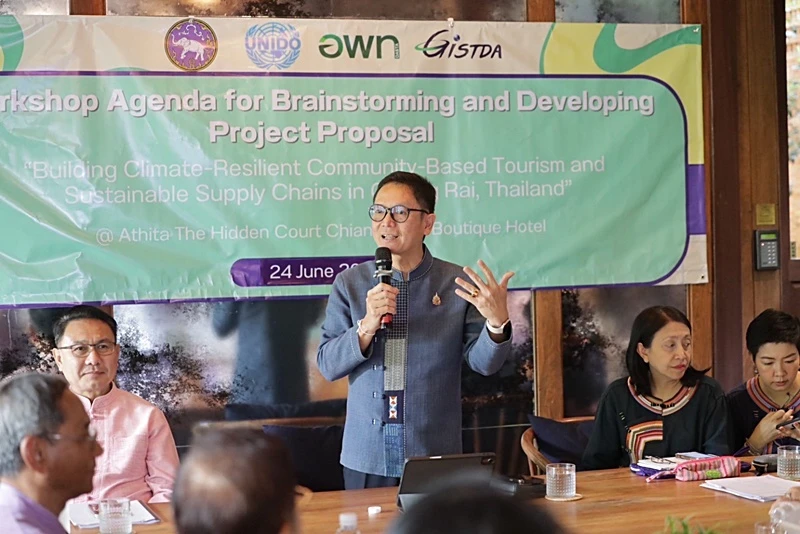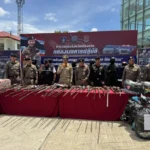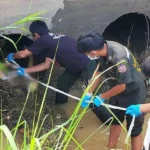CHIANG RAI – The Designated Areas for Sustainable Tourism Administration DASTA, together with Chiang Rai Province, GISTDA and UNIDO, recently brought together government and local groups to discuss plans for a new project: “Building Climate-Adapted Community Tourism and Sustainable Supply Chains in Chiang Rai, Thailand.”
The goal is to shape Chiang Rai as a leading example of how tourism areas can prepare for climate change while supporting long-term supply chain sustainability.
Mr. Rujtitsak Rangsee, Deputy Governor of Chiang Rai, explained that Chiang Rai stands out for its rich history, cultural heritage, and natural beauty. Home to diverse ethnic groups and local communities, Chiang Rai boasts well-known landmarks such as Phra That Doi Tung, Mae Sai border, the Golden Triangle, Doi Tung development project, Kok and Mekong rivers, hot springs, Doi Mae Salong, Phu Chi Fa, and Wat Rong Khun.
The province is also a key gateway for trade, investment, tourism and transport within the GMS economic grouping, generating roughly 100 billion baht in GDP and attracting more than 6 million visitors per year. Chiang Rai’s vision is to become a “creative, contemporary tourism city with high-value agriculture and a balanced environment, moving towards sustainability.”
Natural Disasters
Despite its strengths, Chiang Rai still faces many challenges. Droughts, floods, landslides, earthquakes and changing weather patterns affect agriculture, daily life and the local economy, especially in tourism and rural communities. The new project aims to help tackle these problems and support sustainable development for both the city and its tourism sector.
Siripakorn Cheawsamoot, Director of DASTA, said tourism is a leading source of income for Thailand, but it is also one of the most vulnerable sectors to climate change, with Thailand ranked 9th in the world for climate risk.
Local tourism, community-based tourism and nature tourism are especially at risk from floods, droughts, heatwaves and landslides, which are becoming more common due to climate change.
This has real impacts on local livelihoods and the continued growth of tourism in Chiang Rai. Thailand’s National Adaptation Plan (NAP 2024) recognises tourism as a key sector for climate adaptation.
However, local capacity to manage these risks remains limited, so there is a pressing need to plan and act. DASTA is working together with the United Nations Industrial Development Organisation (UNIDO) and other partners to develop the “Building Climate-Adapted Community-Based Tourism and Sustainable Supply Chains in Chiang Rai, Thailand” project.
This project is designed to boost climate readiness in Chiang Rai tourism through four main steps:
- Gather and use local climate risk data to help plan tourism activities.
- Adapt tourism services and infrastructure using nature-based solutions, seasonal planning and better zoning for high-risk areas.
- Improve and fund tourism value chains to better handle climate impacts.
- Share knowledge, track progress and promote learning at the regional level.
The project will directly help more than 25,000 people, including over 250 local tourism operators and community groups. It will also support ecosystem conservation, water access and gender equality.
The project’s main focus is on Mae Fah Luang, Mae Chan, Mae Sai and Chiang Saen districts, where tourism has been hit hard by climate-related problems. These areas will become model zones for climate adaptation and sustainable supply chains in tourism.
Ms Virpi Stucki, Chief of Fair Production, Sustainability Standards and Trade at UNIDO, shared her enthusiasm for the joint initiative, calling it a significant step for all involved. She stressed that this is more than just a project: it’s a plan to empower local communities, encourage eco-friendly small businesses and protect the stunning landscapes that make Chiang Rai and Thailand world-famous.
Working with DASTA, Chiang Rai, and GISTDA shows what’s possible when innovation, data and local involvement come together. The next step is to finalise the project concept and submit it to the Adaptation Fund.
This project will link climate adaptation with sustainable tourism by using data-driven planning, local action, nature-based infrastructure and financial support to close gaps and build climate governance. With the right support, it could put Thailand at the forefront of smart, climate-ready tourism in the region and provide a blueprint for other destinations.














